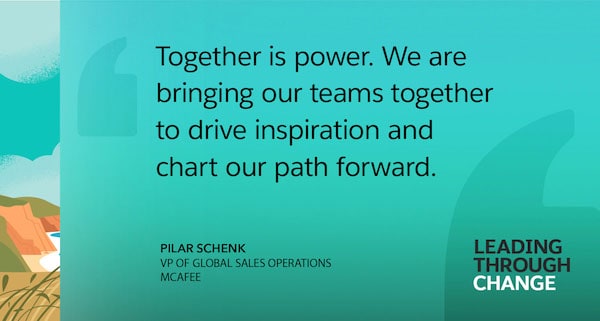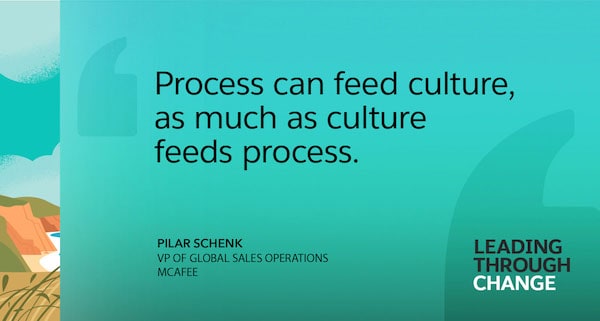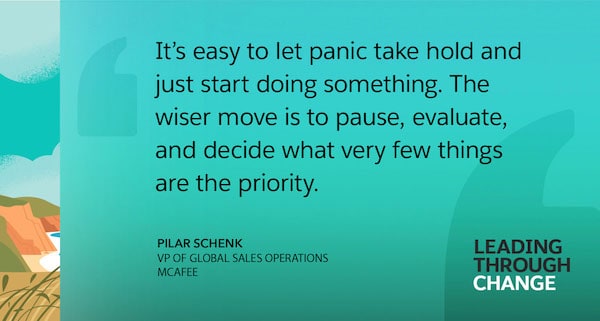3 steps to create a strong sales culture in a remote team



While the world battles a health crisis, businesses are facing another imminent threat: cyberattacks. The number of security threats has surged as hackers capitalised on the vulnerabilities unveiled by the nearly overnight transition to remote work. McAfee’s VP Global Sales Operations Pilar Schenk shares how she and her team helped reps sell from home at a critical time.
Like everyone else, our sellers are adjusting to new circumstances. They’re balancing personal pressures. And they’re trying to get back into their selling groove without the same resources they had in the office.
That’s where my team and I come in. As Vice President of Global Sales Operations, I’m in charge of arming our 1,200 sellers around the globe with the tools they need to be effective. We dug deep into our organisation to figure out what drives sales in our office and how we could translate that to selling from home. (Spoiler alert: it involved creating a virtual sales culture.) Here’s how we did it:

Step 1: Understand Sellers’ Needs
I started simply by asking what my colleagues were hearing from their sales teams. What did our frontline salespeople need to be as successful at home as they were in the office? The resounding answer was people. Just people.
Our inside sales team especially felt the loss of their fellow sellers – and all the fun and friendly competition that went along with being in the same room. Before COVID-19, walking onto their floor felt electric. You’d see people laughing, high-fiving to celebrate a deal closing and teasing each other about who has the best numbers. That motivating force disappeared overnight.
Our field sellers missed the camaraderie with their account teams and customers. They enjoyed working with the same sales engineers and customer success managers on deal after deal, striving towards a common goal. They longed to see the customers they visited on a regular basis.
Without these simple human interactions, our sellers couldn’t find their natural sales rhythm. They devoted huge amounts of time and mental energy trying to recreate their old routines, when what they really needed was a new routine – one that took into account the professional and personal challenges of virtual selling. As a sales ops team, our next step was to arm our reps with tools that would enable them to reconnect and ultimately get the work done.

Step 2: Enable Reps With Technology
A big part of modern sales operations is evaluating, selecting and implementing the right tools to help your sales team members do their jobs. Though crises can make us want to jump into action right away, it’s important to take stock of the tools you already have that solve the challenge at hand. Ask yourself:
- What is critical?
- What do you already use, but maybe not at full capacity?
- What tools are ready to be deployed?
- What else do you need?
In my case, we had several critical tools already in place to enable our teams to work from home, including video conferencing, an internal social network and a centralised training portal. Altogether, they formed a solid foundation as our reps transitioned to virtual sales.
We were also already using Quip, a productivity tool that allows sales reps to virtually collaborate on a document or spreadsheet in real time. McAfee had introduced it earlier this year at our sales kickoff to great excitement, but we hadn’t fully rolled it out yet. With everyone suddenly in different physical locations, virtual collaboration in Quip went from optional to mission-critical. Adoption rates soared, which ultimately created a solid foundation for us to build out collaboration processes in Quip able to withstand anything thrown our way.
In terms of what we had at the ready, McAfee was planning to deploy Salesforce’s High Velocity Sales to streamline our processes and boost productivity. COVID-19 sped up that launch, and it was the perfect solution to our reps’ lack of routine. High Velocity Sales let our managers set up best practices for every rep to follow, and it gave them work queues to keep reps focused on the best next step – who to reach out to, how and when.
You may eventually get to the point where you have the bandwidth to bring in new tools. Before you do, make sure they’re able to generate quick wins or you risk losing your team’s goodwill. We added Salesforce Inbox, a feature that allows our reps to automatically capture their emails in our customer relationship management (CRM) tool and eliminate the manual logging of sales activity. The tool also makes scheduling meetings easier by automatically generating a rep’s availability in emails. Both functions required minimal setup effort, but created huge time savings our reps felt immediately.
Step 3: Bring It Together
Once I understood the problem and the resources that existed, it was time to actually rebuild our sales culture from home.
For inside sales, we returned to the tried-and-true team building exercise: contests. We challenged reps to see how many discovery meetings they could have in a week. The reps got cash prizes for every meeting set and the top performer for each week got a bigger dollar amount. The entire team could see who was winning via the virtual leaderboard, because High Velocity Sales tracked our reps’ activities in real time.
The reps liked the cash, but probably the biggest reward was bragging rights. In the office, we’d display the winners on screens across the sales floor. With everyone at home, we sent out links to those screens and celebrated the winners on team calls. As for me? I’ll consider all those calls and emails my reward!
For field sellers, the culture of togetherness was crucial, and Quip brought people together. Our sellers loved being able to have multiple people work on a document live, receiving automatic notifications about action items, and tracking the progress of their deals. That initial excitement made it easy to encourage sales reps to actually use the tool. In less than a month, we had 350 account plans in Quip and robust conversations taking place in the comments.
With Quip, our field sellers were able to connect with one another and their customers again. Better yet, they recaptured the deep relationships our sellers have with customers. Recreating that part of the culture at home was a huge win.

What I Learned
The most unexpected thing I learned through all of this was that process can feed culture, as much as culture feeds process. We worked hard to help our reps maintain their productivity and managed to recapture the magic of office life along the way. Process and tools to drive culture and business results? That is what sales ops is all about!
My advice for those attempting this at home: focus on simplicity and prioritisation. In times of crisis, it’s easy to let panic take hold and just start doing something. Part of me wished I could buy five new tools just to see what would work. But the wiser move is to take the time to pause, evaluate and decide what few simple things – and I mean very few – are the priority.
And if all else fails, lean on your team to get you through. McAfee’s mantra ‘together is power’ was something I repeated to myself throughout this process. It helped me remember through difficult times that we are bringing our teams together to drive inspiration and chart our path forward.
For more content, tools and tips to help your business thrive in the current climate, visit Work.com.
For more sales tips, download our ebook: 50 Pro Sales Tips for 2020.
Pilar Schenk is VP Global Sales Operations at McAfee.





















